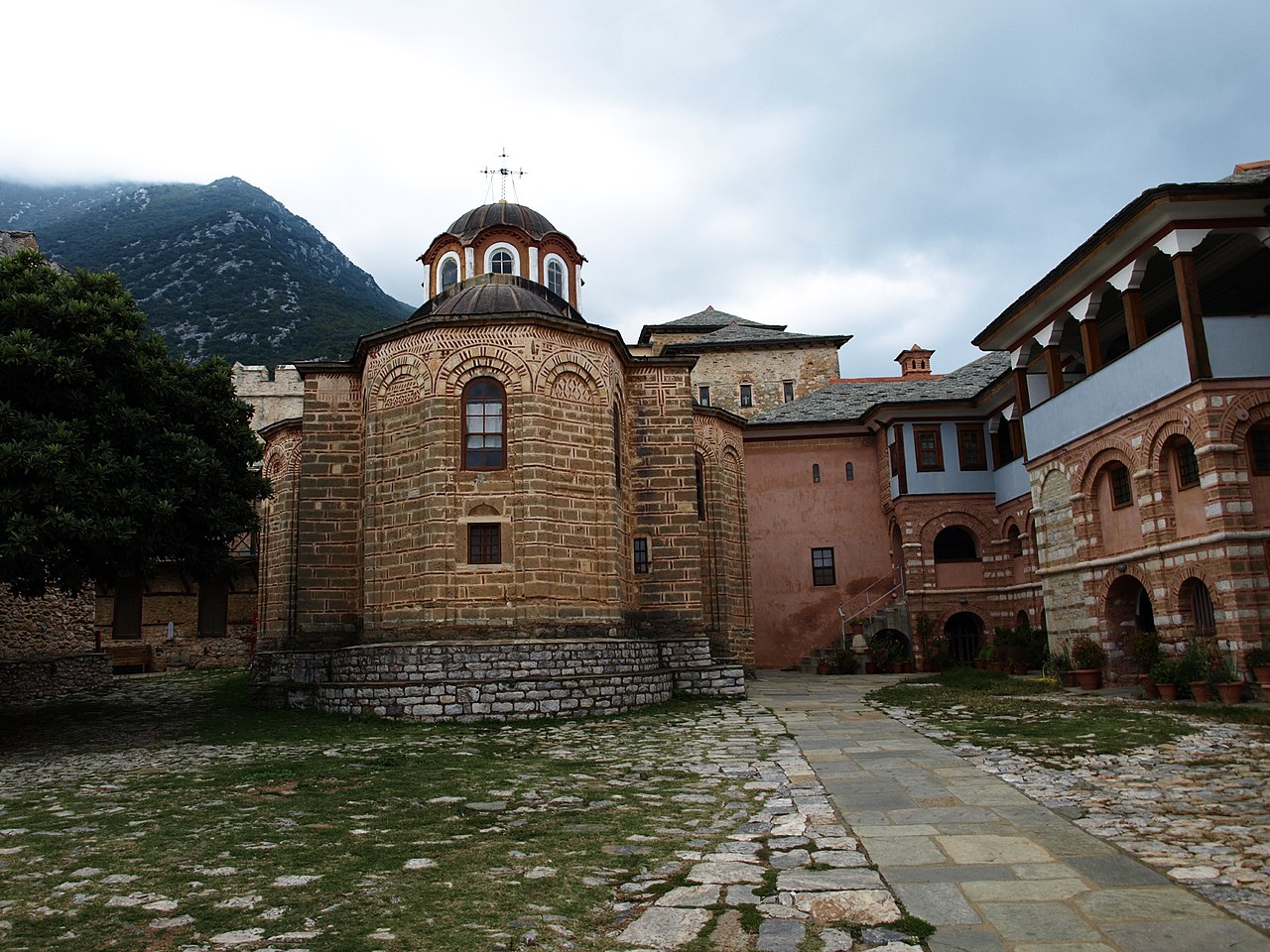The Mone Megistes Lavras (Monastery of the Great Lavra: RISM siglum GR-AOml) is not only one of the richest and biggest Lavra monasteries of the Holy Mount Athos, it has also a famous collection of Old Byzantine sticheraria according to the local Chartres family (the lost Chartres fragment Ms. 1754 which gave the name to this notation and which was not found after the destruction, belonged actually with its six folios to the pentekostarion of Ms. γ 67, between folios 81 and 82 according to the current numbering) and one heirmologion which is probably the oldest chant book fully provided with notation. The Library of Congress published its microfilms.
24th canon of the echos protos: Service for Antipascha of “Cyprian the Monk” with Chartres notation (f. 16v)
about 1000 • Heirmologion with archaic Chartres notation organised in canon order with numbered canons and author ascriptions (Andrew of Crete, John the Monk, Kosmas, Cyprian the Monk, Eliah Patriarch of Jerusalem, George Anatolikos, Nikephoros Diakonos, Sinaitikos, Philanthropos), alternative compositions of the same heirmos are listed as “another” (εἱρμὸς ἄλλος), but not numbered:
- Echos protos: Beginning is missing, the manuscript begin with the 4th ode of the tenth canon of 40 canons numbered for this echos (ff.1r-34r).
- Echos devteros: 43 canons, among them also one prosomoion (ff. 34r-74r).
- Echos tritos: 37 canons (ff. 74r-107v).
- Echos tetartos: 47 canons (ff. 107v-156v).
- Echos plagios protos: 41 canons (ff. 156v-191v).
- Echos plagios devteros: 53 canons (ff. 192r-240r).
- Echos varys: 28 canons (ff. 240v-262v).
- Echos plagios tetartos: 54 canons (ff. 263r-312v).
Breviary for Lent with θάμνος νῦν κατίδειν τὸν οὐρανὸν (υαρ) & ὅτε τῷ σταυρῷ προσήλωσαν (πλβ᾽) with Chartres notation
(ff. 44v-45r)
End of pentekostarion with theta notation & προκαθάρωμεν ἑαυτούς ἀδελφοί (α᾽) for Sunday of Apokreos
(ff. 79v-80r)
X • Incomplete triodion and pentekostarion with idiomela and proshomoia. The pentekostarion was partly written with theta notation, following chant of the triodion was notated with Chartres notation. The triodion on folio 1 begins with the end of Saturday of Theodore the Stoudites and Sunday of Orthodoxy. It was reworked with Chartres notation.
Description:
- Triodion beginning Sunday of Orthodoxy and the Doxastikon Μωσῆς τῷ καιρῷ τῆς ἐγκρατείας (πλβ᾽) with Chartres notation and the breviary of Lent with incipits of prokeimena, lessons, psalms etc. with selected notated idiomela (ff. 41v-46r): ff. 1r-49v.
- Pentekostarion partly written with theta notation: ff. 49v-80r.
- Appendix with idiomela and proshomoia of the triodion and the menaion (stichera between 22 and 27 January which are not part of the SAV repertoire): ff. 80r-83v.
Proshomoia to be sung over the hesperinos psalm (Ps 140:1-2) of plagios devteros within the triodion (f. 21r)
XI • Triodion, pentekostarion and oktoechos with Old Byzantine Chartres notation:
- Incomplete Triodion beginning with the fourth week of Lent (ff. 1r-70r)
- Pentekostarion (71v-106r)
- Oktoechos (ff. 107r-158v):
- stichera anatolika (ff. 107r-108v)
- dogmatika. anabathmoi, ainous, stavrotheotokia, and stichera to sing with the hesperinos psalm in oktoechos order (ff. 109-150v)
- stichera heothina with exaposteilaria (ff. 150v-155v)
- stichera anapavsima (ff. 156r-158v).
- list of Chartres neumes (f. 159r).
- Appendix: additional stichera of the triodion (ff. 159v-162v).
Sticheron idiomelon for Theophany (SAV 447) with sticheron for Ainous by “John the Monk” (f. 35v)
ΧΙ • Incomplete menaion with Chartres notation. The first SAV (f.1v) is no. 248 for Peter of Alexandria (24 Nov), the preceding 3 were addressed to St Catherine.
End of the first week after Easter with Theotokia (f. 65r)
ΧΙ • Incomplete triodion and pentekostarion with Chartres notation written by the same scribe. Incomplete Triodion is beginning short before the Holy Week (ff. 1r-41v). The Pentekostarion, beginning with the Easter idiomelon Σήμερον σωτηρία τῷ κοσμῷ in echos protos, is complete (ff. 42r-92v) and includes also theotokia, prosomoia and anatolika and partly several versions of some idiomela.


Replies
On special request of a very special member here, I inserted also a link and a description of the triodion and pentekostarion (GR-AOml γ 12), since it fits the description given in the title.
Just as an explanation, the earliest and most primitive form of notation was theta notation, where a letter θ (meaning “thema”) indicated a longer melisma over a certain melisma of a sticheron idiomelon (a more complex composition whose melos could pass between different echoi). According to recent studies like Mariana Dimitrovna Old Byzantine notation (Chartres in case of Athos and Constantinople, Coislin in case of the Patriarchates of Jerusalem and Alexandria) as well as sematic notation (early znamennaya notatsya) developed out of an “explanation” around notational signs which are known as thematismoi or themata).
In case of Ms. γ 12 there is the hypothesis that the whole manuscript once looked like the pentekostarion, while the triodion was elaborated by a later layer of Chartres notation.
As an example I chose here folio 79 verso, where you find a famous sticheron for Allsaints (Sunday after Pentecost) beginning δεῦτε πιστοί σήμερον in echos plagios devteros (part of the SAV repertoire). It has a θ over the second syllable of the second word which looked in a revised sticherarion of the 14th century like this:
It explains the dynamic concept of early sticherarion notation, even before a theory about the great signs was developed to integrate the gestic notation of the cheironomiai used in the Asmatikon.